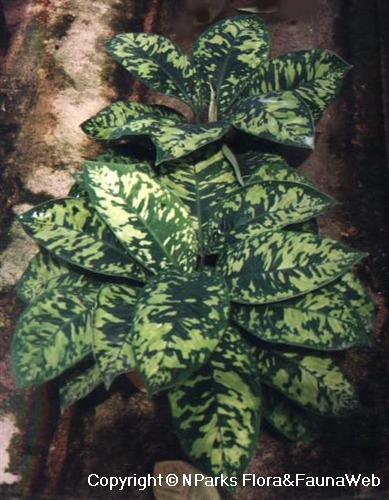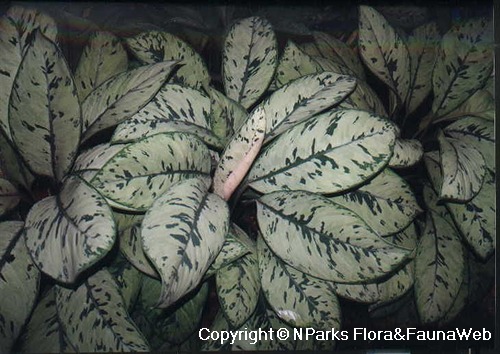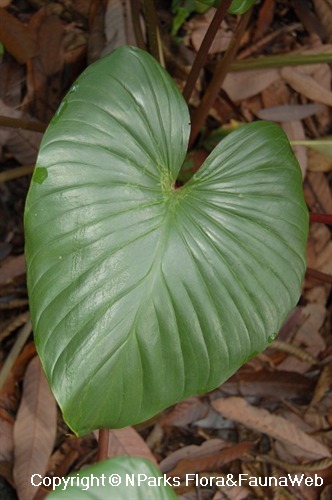
Name
Classifications and Characteristics
| Plant Division | Angiosperms (Flowering Seed Plants) (Monocotyledon) |
|---|---|
| Plant Growth Form | Herbaceous Plant |
| Lifespan (in Singapore) | Perennial |
| Mode of Nutrition | Autotrophic |
Biogeography
| Preferred Climate Zone | Tropical |
|---|---|
| Local Conservation Status | Non-native |
Description and Ethnobotany
| Others - Plant Morphology | Growth Form: Evergreen, herbaceous shrub with erect growth habit. Foliage: Large, ovate leaves have a mottled pattern of dark green, light green and yellow patches. Flowers: Unisexual flowers resemble calla lily flowers. The flower consists of a white stick-like spadix and brownish petal-like spathe that surrounds the spadix like a hood. Fruits: Fleshy fruits are known as berries. Landscaping: This species is grown for its large, variegated leaves. It is suitable for container plantings and makes an ideal houseplant. This species is relatively rare in the horticultural trade, and thus, provides a unique look as a specimen plant. Cultivation: This species is easy to grow. It should be planted in fertile, well-draining soil that is kept moist. It can tolerate shady conditions, but it will grow best under partial shade. It requires a humid environment, so daily misting is needed. It is resistant to most diseases. Propagation: Propagate by stem cuttings. Etymology: The genus "Homalomena" is derived from the Greek words for flat ("homalos") and moon ("mene"). The name is a translation of the common name of a plant. The species epithet "wallichii" was named after Dr. Nathaniel Wallich, a Danish surgeon with a keen interest in plants (1786 - 1854). He was founder of the Indian Museum in Calcutta which focused on the flora and fauna of India. He later became Superintendent of the East India Company's Botanical Garden at Calcutta. |
|---|
Landscaping Features
| Desirable Plant Features | Ornamental Foliage |
|---|---|
| Landscape Uses | Container Planting, Interiorscape/ Indoor Plant, General, Focal Plant |
| Thematic Landscaping | Formal Garden |
Plant Care and Propagation
| Light Preference | Semi-Shade |
|---|---|
| Water Preference | Lots of Water |
| Rootzone Tolerance | Fertile Loamy Soils, Well-Drained Soils, Easy to Grow, Disease / Pest Resistant |
| Maintenance Requirements | Low |
| Propagation Method | Division |
Foliar
| Mature Foliage Colour(s) | Green, Yellow / Golden |
|---|---|
| Mature Foliage Texture(s) | Smooth, Leathery |
| Foliar Type | Simple / Unifoliate |
| Foliar Shape(s) | Non-Palm Foliage (Ovate) |
| Foliar Venation | Pinnate / Net |
| Foliar Margin | Entire |
| Foliar Apex - Tip | Acute |
| Foliar Base | Rounded / Obtuse |
| Leaf Area Index (LAI) for Green Plot Ratio | 3.5 (Shrub & Groundcover - Monocot) |
Non - Foliar and Storage
| Stem Type & Modification | Acaulescent |
|---|---|
| Root Type | Underground (Fibrous Root) |
Floral (Angiosperm)
| Flower & Plant Sexuality | Unisexual Flowers , Monoecious |
| Flower Colour(s) | Brown, White |
|---|
| Inflorescence Type | Spathe & Spadix |
| Flowering Habit | Polycarpic |
Fruit, Seed and Spore
| Fruit Classification | Simple Fruit |
|---|---|
| Fruit Type | Fleshy Fruit , Berry |
Image Repository
Others
| Master ID | 813 |
|---|---|
| Species ID | 2108 |
| Flora Disclaimer | The information in this website has been compiled from reliable sources, such as reference works on medicinal plants. It is not a substitute for medical advice or treatment and NParks does not purport to provide any medical advice. Readers should always consult his/her physician before using or consuming a plant for medicinal purposes. |





